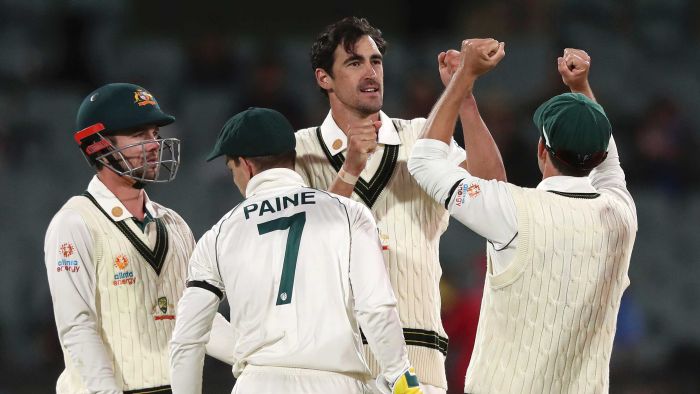If the Indian and Australian cricketers felt a degree of pent-up energy from the claustrophobia of quarantine life, only the home side released it on a dour opening day of the Test summer in Adelaide.
India finished at 6-233, Australia having all the momentum.
If it is remembered at all in years to come, it will be for two events: the moment of insanity that ended Virat Kohli’s characterful innings of 74 in tricky batting conditions, and the first confident steps into Test cricket of Australian all-rounder Cameron Green.
Kohli’s demise when most of the day’s hard work was done beggared belief: his vice-captain Ajinkya Rahane hit a firm drive to Josh Hazlewood at mid-off, took off for a brainless run and immediately reconsidered, leaving Kohli stranded as Nathan Lyon took the bails. Kohli’s look didn’t just kill, it dug a shallow grave on what remains of the Adelaide Oval hill.
Unfortunately, Shane Warne’s pre-play adoption of a tweed flat cap “out of respect for Peaky Blinders and Cameron Green” was the only other truly arresting image of the day. The debutant received warm applause when he stepped forward to deliver the 23rd over of the day, and it was hard not to be thrilled at the sight of the 200-centimetre all-rounder ambling in and bowling at 140kph from what seemed like minimal exertion, knowing greater contributions still could come from his bat.
There was symmetry to Green’s nonchalant bow, coming 50 years to the week since the Test debut of the similarly composed Greg Chappell. Chappell’s recent decades have been devoted to Australian cricket’s pursuit of youthful talent. He considers Green the best Australian batting talent since Ricky Ponting. No pressure.
Pressure was the name of the game on day one. From Australia’s bowlers, it never let up. Tennis ball bounce and a slow outfield made things tough for India’s batsmen, and Australia’s quicks made them tougher. It was not until the pink ball was 65 overs old and as useful to the pacemen as a dish rag that Kohli was able to play with anything close to flair.
Four overs after his calamitous departure, the second new ball arrived and Rahane was trapped in front by Mitchell Starc. A lethal customer in day-night Tests, Starc’s previous seven had yielded 42 wickets at 19.24. There can’t be many worse fates in sport than facing him under lights with a brand new pink Kookaburra in his hand.
In fact, Starc had India on the back foot from the first over of the day. It is always tempting to draw hasty conclusions from the opening moments of a Test summer — who can forget Michael Slater’s devil-may-care slashes through cover setting the tone for the domineering teams of the Taylor-Waugh years? Here again was an ill omen for a visiting team: hit-and-miss Starc vs hit-and-miss Prithvi Shaw.




Talked up as the neo-Sehwag, Shaw fulfilled only the least desirable aspect of that remit, his feet not budging an inch as his head and bat lurched forward to Starc’s second delivery of the day, exposing the gap through which an inside-edge disrupted his bails.
What told again was the discipline and relentless efficiency of Australia’s attack. Bad balls were anomalies. The case in point was Josh Hazlewood, whose figures of 1-47 from 20 overs undersell the difficulty he caused all day for India’s batsmen.
CricViz analyst Ben Jones recently published a study highlighting Hazlewood’s under-acknowledged genius: not only does the understated paceman hit the perfect line and length with 44 per cent of his Test deliveries, he does it at an average speed nudging 140kph, the kind of velocity at which others struggle for control.
There is also the matter of Hazlewood’s height, which allows him to release the ball from 2.17 metres — an awkward trajectory comparable to predecessors like Steve Harmison, Morne Morkel and Andrew Flintoff. The Australian’s unmatched combination of pace, accuracy and steepling bounce make him a tricky proposition on even docile surfaces like this Adelaide pitch. He and Pat Cummins barely bowled a bad ball all day.




Che Pujara was the other unassuming joy in his innings of 43. The Indian number three is a man of few words and today, a batsman with no backlift.
For 163 deliveries, he calmly deflected the ball away and squinted at the sun like a Spaghetti western cowboy. He batted for 31 hours and 1,258 deliveries to lead India to its historic victory in the 2018-19 series. Among the Australians, only Nathan Lyon — who dismissed him for the 10th time in Tests on Thursday and dragged the game out of its slumber — looks to have his number.
You’d hope that Test cricket agnostics didn’t tune in to the early stages today. Australia bowled a dismal 12 overs in the first hour of play and only 25 all up in the first session. The other great shame was the needless extinguishment of Kohli’s knock, although he’d given chances.
Was he more determined than normal to make this game count, given he will fly home at its conclusion for the birth of his first child? His batting spoke of quiet determination and a suppression of ego — a quality that will be required by all for the remainder of this contest.







